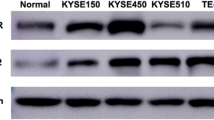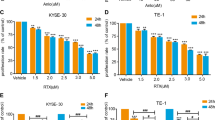Abstract
Purpose
As reported, epidermal growth factor receptor (EGFR) is over expressed in a variety of cancers including esophageal squamous cell carcinoma. Therefore, it becomes one of the potential targets for treating esophageal cancer. Pingyangmycin (PYM), a single A5 component of bleomycin, is currently used for the treatment of different types of cancers of epidermal origin, especially for head and neck cancers. In this report, the effect of PYM on EGFR expression in human esophageal cancer cells and the therapeutic efficacy of the combination of PYM and cetuximab on esophageal cancer xenograft were investigated.
Methods
The effects of PYM, cetuximab and the combination on EGFR signaling, proliferation, cell cycle, apoptosis were evaluated by using MTT, Western blotting, RT-PCR assays and flow cytometry assays, respectively, in vitro and the therapeutic efficacy by a xenograft model in athymic mice.
Results
Cell volume and nucleus were enlarged after PYM treatment. PYM showed potent cytotoxicity in both cell lines of Kyse-150 and Eca-109 in time and dosage-depended manner in MTT assay. PYM treatment induced G2/M phase arrest and apoptosis. Notably, the expression of EGFR was down-regulated by PYM in EGFR highly expression esophageal cancer cells. PYM plus cetuximab resulted in a potentiation of antiproliferative activity. PYM combined with cetuximab displayed a much higher therapeutic effect than that of the single agent on esophageal cancer xenograft in athymic mice.
Conclusions
PYM could down-regulate the expression of EGFR in esophageal cancer cells and potentiate the effects of cetuximab on esophageal cancer xenograft in nude mice. The combination of PYM and cetuximab, the EGFR-targeted combination of a chemotherapeutic agent and an antibody-based drug, might be useful in cancer therapy.







Similar content being viewed by others
References
Zhen YS, Li DD, Li Q et al (1981) Studies on antitumor effect and pharmacology of pingyangmycin. Topics on cancer chemotherapy. In: Proceedings of international symposium on adriamycin and other drugs in antitumor chemotherapy, China Academic Publishers, pp 211–224
Zhen YS, Li DD (2009) Antitumor antibiotic pingyangmycin: research and clinical use for 40 years. Chin J Antibiot 34:577–580
Byrnes RW, Templin J, Sem D, Lyman S, Petering DH (1990) Intracellular DNA strand scission and growth inhibition of Ehrlich ascites tumor cells by bleomycins. Cancer Res 50:5275–5286
Chen J, Stubbe J (2005) Bleomycins: towards better therapeutics. Nat Rev Cancer 5:102–112
Williams ED, Merrick MV, Lavender JP (1975) The distribution and dosimetry of 111In-Bleomycin in man. Br J Radiol 48:275–278
Homs MY, Voest EE, Siersema PD (2009) Emerging drugs for esophageal cancer. Expert Opin Emerg Drugs 14:329–339
Mariette C, Piessen G, Triboulet JP (2007) Therapeutic strategies in esophageal carcinoma: role of surgery and other modalities. Lancet Oncol 8:545–553
Gebski V, Burmeister B, Smithers BM, Foo K, Zalcberg J, Simes J (2007) Survival benefits from neoadjuvant chemoradiotherapy or chemotherapy in esophageal carcinoma: a metaanalysis. Lancet Oncol 8:226–234
Schlessinger J (2000) Cell signaling by receptor tyrosine kinases. Cell 103:211–225
Gibault L, Metges JP, Conan-Charlet V, Lozac’h P, Robaszkiewicz M, Bessaguet C, Lagarde N, Volant A (2005) Diffuse EGFR staining is associated with reduced overall survival in locally advanced oesophageal squamous cell cancer. Br J Cancer 93:107–115
Itakura Y, Sasano H, Shiga C, Furukawa Y, Shiga K, Mori S, Nagura H (1994) Epidermal growth factor receptor overexpression in esophageal carcinoma. An immunohistochemical study correlated with clinicopathologic findings and DNA amplification. Cancer 74:795–804
Yano H, Shiozaki H, Kobayashi K, Yano T, Tahara H, Tamura S, Mori T (1991) Immunohistologic detection of the epidermal growth factor receptor in human esophageal squamous cell carcinoma. Cancer 67:91–98
Hanawa M, Suzuki S, Dobashi Y, Yamane T, Kono K, Enomoto N, Ooi A (2006) EGFRprotein overexpression and gene amplification in squamous cell carcinomas of the esophagus. Int J Cancer 118:1173–1180
Miyawaki M, Hijiya N, Tsukamoto Y, Nakada C, Kawahara K, Moriyama M (2008) Enhanced phosphorylation of the epidermal growth factor receptor at the site of tyrosine 992 in esophageal carcinomas. APMIS 116:1097–1106
Carneiro A, Isinger A, Karlsson A, Johansson J, Jönsson G, Bendahl PO, Falkenback D, Halvarsson B, Nilbert M (2008) Prognostic impact of array-based genomic profiles in esophageal squamous cell cancer. BMC Cancer 11:98–106
Boone J, van Hillegersberg R, Offerhaus GJ, van Diest PJ, Borel Rinkes IH, Ten Kate FJ (2009) Targets for molecular therapy in esophageal squamous cell carcinoma: an immunohistochemical analysis. Dis Esophagus 22:496–504
Cao SS, Zhen YS (1989) Potentiation of antimetabolite: antitumor activity in vivo by dipyridamole and amphotericin B. Cancer Chemother Pharmacol 24:181–186
Zhen YS, Taniki T, Weber G (1992) Azidothymidine and dipyridamole as biochemical response modifiers: synergism with methotrexate and 5-fluorouracil in human colon and pancreatic carcinoma cells. Oncol Res 4:73–88
Matar P, Rojo F, Cassia R, Moreno-Bueno G, Di Cosimo S, Tabernero J, Guzmán M, Rodriguez S, Arribas J, Palacios J, Baselga J (2004) Combined epidermal growth factor receptor targeting with the tyrosine kinase inhibitor gefitinib (ZD1839) and the monoclonal antibody cetuximab (IMC-C225): superiority over single-agent receptor targeting. Clin Cancer Res 10:6487–6501
Yokoyama Y, Dhanabal M, Griffioen AW, Sukhatme VP, Ramakrishnan S (2000) Synergy between angiostatin and endostatin: inhibition of ovarian cancer growth. Cancer Res 60:2190–2196
Wei Q, Chen L, Sheng L, Nordgren H, Wester K, Carlsson J (2007) EGFR, HER2 and HER3 expression in esophageal primary tumours and corresponding metastases. Int J Oncol 31:493–499
Langer R, Von Rahden BH, Nahrig J, Von Weyhern C, Reiter R, Feith M, Stein HJ, Siewert JR, Höfler H, Sarbia M (2006) Prognostic significance of expression patterns of c-erbB-2, p53, p16INK4A, p27KIP1, cyclin D1 and epidermal growth factor receptor in oesophageal adenocarcinoma: a tissue microarray study. J Clin Pathol 59:631–634
Bonner JA, Harari PM, Giralt J, Azarnia N, Shin DM, Cohen RB, Jones CU, Sur R, Raben D, Jassem J, Ove R, Kies MS, Baselga J, Youssoufian H, Amellal N, Rowinsky EK, Ang KK (2006) Radiotherapy plus cetuximab for squamous-cell carcinoma of the head and neck. N Engl J Med 354:567–578
Safran H, Suntharalingam M, Dipetrillo T, Ng T, Doyle LA, Krasna M, Plette A, Evans D, Wanebo H, Akerman P, Spector J, Kennedy N, Kennedy T (2008) Cetuximab with concurrent chemoradiation for esophagogastric cancer: assessment of toxicity. Int J Radiat Oncol Biol Phys 70:391–395
Gold PJ, Goldman B, Iqbal S, Leichman LP, Lenz HJ, Blanke CD (2010) Cetuximab as second-line therapy in patients with metastatic esophageal cancer: a phase II Southwest Oncology Group Study. J Thorac Oncol 5:1472–1476
Ku GY, Shah MA, Tang LH, Miron B, Kelsen DP, Ilson DH (2008) Cetuximab (C225) plus irinotecan/cisplatin (CPT/Cis) for CPT/Cis-refractory esophageal cancer. J Clin Oncol 26(Supplement; ASCO Meeting Abstracts):15580
Hollstein MC, Smits AM, Galiana C, Yamasaki H, Bos JL, Mandard A, Partensky C, Montesano R (1988) Amplification of epidermal growth factor receptor gene but no evidence of ras mutations in primary human esophageal cancers. Cancer Res 48:5119–5123
Hollstein MC, Peri L, Mandard AM, Welsh JA, Montesano R, Metcalf RA, Bak M, Harris CC (1991) Genetic analysis of human esophageal tumors from two high incidence geographic areas: frequent p53 base substitutions and absence of ras mutations. Cancer Res 51:4102–4106
Lyronis ID, Baritaki S, Bizakis I, Krambovitis E, Spandidos DA (2008) K-ras mutation, HPV infection and smoking or alcohol abuse positively correlate with esophageal squamous carcinoma. Pathol Oncol Res 14:267–273
Nakayama Y, Igarashi A, Kikuchi I, Obata Y, Fukumoto Y, Yamaguchi N (2009) Bleomycin-induced over-replication involves sustained inhibition of mitotic entry through the ATM/ATR pathway. Exp Cell Res 315:2515–2528
Zhou BB, Elledge SJ (2000) The DNA damage response: putting checkpoints in perspective. Nature 408:433–439
Benhar M, Engelberg D, Levitzki A (2002) ROS, stress-activated kinases and stress signaling in cancer. EMBO Rep 3:420–425
Oliveras-Ferraros C, Vazquez-Martin A, López-Bonet E, Martín-Castillo B, Del Barco S, Brunet J, Menendez JA (2008) Growth and molecular interactions of the anti-EGFR antibody cetuximab and the DNA cross-linking agent cisplatin in gefitinib-resistant MDA-MB-468 cells: new prospects in the treatment of triple-negative/basal-like breast cancer. Int J Oncol 33:1165–1176
Conflict of interest
None.
Author information
Authors and Affiliations
Corresponding author
Rights and permissions
About this article
Cite this article
Gong, Jh., Liu, Xj., Li, Y. et al. Pingyangmycin downregulates the expression of EGFR and enhances the effects of cetuximab on esophageal cancer cells and the xenograft in athymic mice. Cancer Chemother Pharmacol 69, 1323–1332 (2012). https://doi.org/10.1007/s00280-012-1827-9
Received:
Accepted:
Published:
Issue Date:
DOI: https://doi.org/10.1007/s00280-012-1827-9




